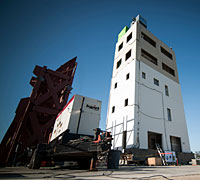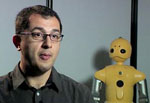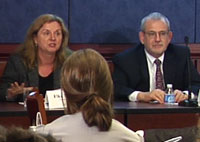Each month, the NSF Current newsletter highlights research and education efforts supported by the National Science Foundation. If you would like to automatically receive notifications by e-mail or RSS when future editions of NSF Current are available, please use the links below:
![]() Subscribe to NSF Current by e-mail |
Subscribe to NSF Current by e-mail | ![]() What is RSS? |
What is RSS? | ![]() Print this page |
Print this page | ![]() Return to NSF Current Archive
Return to NSF Current Archive

A recent study of emperor penguins illustrates just how much research has changed since 1844, when physician-naturalists first published a detailed description of the tall, portly bird. The ships and crew of the British expedition captained by James Clark Ross endured pack ice, freezing temperatures and damage from severe gales to find the magnetic pole and survey the botany and zoology of the Antarctic continent.
More recently, researchers interested in the sustainability of the population conducted a satellite survey of Antarctica's emperor penguins, finding twice as many as previously estimated. The 2009 survey counted almost 600,000 birds. Scientists are focusing on the species and its habitat partly because emperor populations appear to be threatened by climate change.
On the ice, the emperor penguins' black and white plumage stands out against the snow, making colonies clearly visible in satellite imagery. This allowed the team to analyze 44 emperor penguin colonies along the coast of Antarctica, including seven previously unknown colonies. Using a technique known as pan-sharpening to increase the resolution of the satellite imagery, the scientists were able to differentiate between birds, ice, shadow and penguin waste, or guano. The researchers used ground counts and aerial photography to refine the estimates. NSF-funded team member Michelle LaRue from the University of Minnesota explains the process in this video.
Adelie penguins in the Ross Sea region of Antarctica are also of concern because of observed population shifts; read more in the NSF Highlight "What Is Going On With the Adelie Penguin Populations?"

What happens when you put a five-story building, fully equipped with an intensive care unit, surgery suite, piping, air conditioning, elevator and fire barriers, through a series of high-intensity earthquakes?
Structural engineers at the University of California-San Diego sought the answers during NSF-supported tests in April and May on the world's largest outdoor shake table, located at the Englekirk Structural Engineering Center. The shake table is one of the largest experimental facilities in the NSF-funded George E. Brown, Jr., Network for Earthquake Engineering Simulation.
The building was subjected to motions equivalent to those experienced during several earthquakes: the 6.7-magnitude in Northridge, Calif., in 1994; 7.9-magnitude in Alaska in 2002; 8.0-magnitude in Peru in 2007; and 8.8-magnitude in Chile in 2010. Among other objectives, the simulations tested large, cylindrical rubber bearings for their ability to isolate a building from the lateral motion experienced during a temblor, or earthquake vibration. The initial report from these tests was positive.
More than 500 sensors and 70 cameras throughout the building recorded movement and measured how building components performed. After the shake tests, engineers conducted additional tests of the building's fire-protection systems. The team, including partners at San Diego State University, Howard University and Worcester Polytechnic University, will analyze the results for the coming year. View videos of the shake tests and interviews with the engineers.

Representatives from 44 nations participating in a Global Summit on Merit Review at NSF on May 14-15 released a set of merit review principles and established a Global Research Council. The merit review principles, crafted by summit leaders, include expert assessment, impartiality, confidentiality and other factors deemed important to a rigorous and transparent system for evaluating proposals for research funding.
Participants included the heads of research councils and agencies from the Group of 20 (G-20) and Organization for Economic Co-operation and Development (OECD) countries, which are typically research intensive, as well as countries with emerging scientific enterprises. The latter included nations in the U.S. State Department's Science Envoys program. The merit review process, as practiced by NSF and other leading funding agencies, is widely recognized as an essential tool for selecting the most promising proposals for scientific research. The summit participants identified what they believe are the best practices and standards for both national institutions and multinational cooperation. View a video of the introductory session and read an editorial in the journal Science by NSF director Subra Suresh.

NSF Director Subra Suresh was elected to the National Academy of Sciences in May, as one of 84 new members and 21 foreign associates. He was appointed as the NSF director in 2010. Read about his other honors here.
At its May meeting, the National Science Board elected Dan Arvizu as chairman, Kelvin Droegemeier as vice chairman, and Carl Lineberger to serve on the Executive Committee. Both Arvizu and Droegemeier have served on the board since 2004, and Lineberger since 2011. Read more.

In 2010, a team of archaeologists working in a dense rain forest in Guatemala discovered a rich collection of artwork in the largely unexcavated Maya city of Xultun. The find includes a vibrant wall mural of a king surrounded by several figures--possibly artist-scribes--and columns of mathematical calculations. The calculations, recorded in the ninth century, have now been carefully documented and characterized by the researchers.

According to the researchers, the mathematical hieroglyphs project a calendar of cosmic events--including movements of the moon, Venus and Mars--some 7,000 years into the future. These projections counter a modern myth that the Maya thought the world would end in 2012. The astronomical tables are found in Maya books from later centuries, but this is the earliest record found so far.
William Saturno of Boston University led the team that uncovered the vivid drawings. Heather Hurst of Skidmore College in New York serves as project illustrator. Since 2010, Hurst has recorded the drawings with detailed illustrations of her own and has studied the ancient pigments. Portable x-ray fluorescence equipment, acquired by Skidmore College with an NSF Major Research Instrumentation grant, was used to help analyze the wall-painting materials and techniques. Saturno and Hurst receive other NSF funding as well.
The ruins at Xultun, home to thousands of Maya between the first century B.C. and ninth century A.D., are one of several sites being excavated in the Central American country's Petén region, an area of lakes, swamps and other lowlands. Saturno is currently investigating the history of the site.
National Geographic, which provided primary funding for the Xultun expedition, will feature the rare artwork in its June magazine.
Read an NSF Highlight about a separate project to preserve the indigenous language of one of the Maya peoples in the Petén region, which resulted in a published dictionary.

When it comes to communication, our eyes say a lot—about whether we're paying attention, our mental state and our role in a conversation. NSF-supported computer scientists Bilge Mutlu and Michael Gleicher of the University of Wisconsin-Madison are analyzing characteristics of the human gaze and creating algorithms to reproduce those eye movements in robots and animated characters.
Mutlu, a specialist on human-computer interaction, believes there will be significant benefits to making robots and animated characters "look" like humans do. For example, robot eye movements can help people understand instructions given by a robot or learn from a robot teaching in the classroom. Learn more in this video.
Scientists Discover 24 New Lizard Species in Caribbean (Christian Science Monitor) NSF-funded biologists reported two dozen previously unknown "skink" species, some at risk of extinction.
U.S. Materials Initiative Gains Momentum (Nature) The national Materials Genome Initiative, launched in 2011, includes the NSF grant program "Designing Materials to Revolutionize and Engineer our Future."
No Place for Heated Opinions (New York Times) "Frozen Planet," the NSF-supported Discovery Channel series that documents many of the extremes on Earth, has attracted millions of viewers.

When making decisions about energy use, people tend to default to the status quo, Elke Weber said at a May 23 congressional briefing. Weber, an NSF-funded psychologist from Columbia University, said that motivations for choosing cleaner energy alternatives could include making them the "default" option when consumers are faced with a choice.
Economist Hunt Allcott of New York University described how labeling, social comparisons and pricing can affect people's perceptions of economic value and, in turn, encourage alternative energy choices. Myron Gutmann, NSF Assistant Director for Social, Behavioral and Economic Sciences, kicked off the event with an overview of how research in those sciences increases understanding of the decision process.
The event, "Human Behavior: Influences on Energy Choices," was the ninth in the series The Road to the New Energy Economy. NSF, DISCOVER magazine, IEEE and the American Society for Manufacturing Engineers sponsored the briefing. Senator Harry Reid, Majority Leader, served as honorary host.
Funding from the American Recovery and Reinvestment Act of 2009 (ARRA) helped increase university spending on research and development (R&D) by 7 percent, to $61.2 billion, from FY 2009 to FY 2010. The $2.7 billion provided by ARRA in FY 2010 boosted the federal government's portion of academic R&D spending to $37.5 billion. The data are from NSF's annual Higher Education Research and Development Survey.
Most of the university R&D spending in FY 2010 was in life sciences ($34.9 billion), followed by engineering ($9.3 billion). R&D expenditures increased for all fields except social sciences, which declined by more than 4 percent. However, some of this decline may be because universities changed how they classified R&D spending, due to a redesign of the survey. Read more in an InfoBrief from NSF's National Center for Science and Engineering Statistics.



